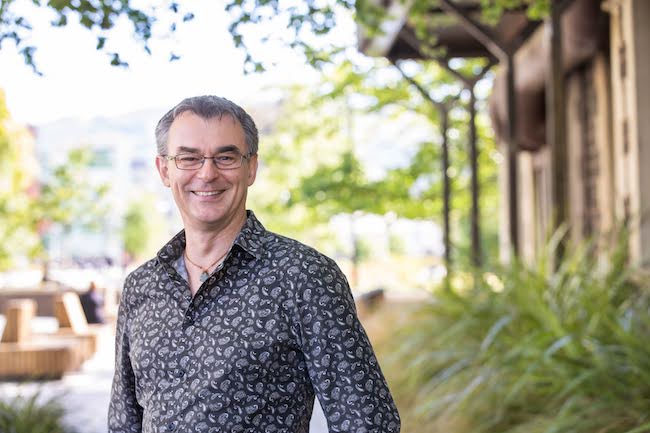Tuesday 18 October 2022 11:13am

Congratulations to our own Michael Black who this year was promoted to Professor on the back of a stellar academic career bringing statistics to biomolecular research.
Mik's focus is on using statistics and computational tools to wrangle the huge datasets integral to modern biomolecular research, mainly applied to human diseases such as cancer, but also in agricultural and horticultural research. His ability to form strong collaborations with researchers across many disciplines and places underpins his research success.
Mik also helps to provide high performance computing tools for the New Zealand research community via the National eScience Infrastructure (NeSI), and to develop national genomics resources through Genomics Aotearoa.
As a teacher, Mik equips legions of undergraduate and postgraduate students with invaluable knowledge of statistics and computer-based analysis of genomic data, and has helped to incorporate Te Ao Māori concepts into his students' understanding of this research.
Originally receiving his BSc (Hons) in statistics from the University of Canterbury, Mik started his research career in the USA, with a Master of Science in mathematical statistics and PhD in statistics from Purdue University, Indiana. After finishing his PhD in 2002, he landed a job as a lecturer in the Department of Statistics at the University of Auckland.
Les McNoe invited him to speak at an Otago Genomics Facility Meeting in early 2004, and soon after that Mik started working closely with Tony Reeve to analyse some of the colorectal cancer microarray data that Tony had been generating with his team in the Cancer Genetics Laboratory in the Department of Biochemistry.
On the back of this and other Dunedin-based collaborative genomics projects, Mik interviewed for a position at Otago University, and he arrived in the Biochemistry Department in May 2006.
Mik generously shared with us some memories of his early days in the Department.
“My first office was in a small internal room (shared with one of my PhD students who had come with me from Auckland) just off the pre-renovation Ledgerwood lab on the second floor. One of the first people I remember coming to talk to me was Russell Poulter - I had worked with Rob Martienssen at Cold Spring Harbour during my PhD, and Russell wanted to talk about transposons - and we sure did!”
“The first teaching I did was in the now-defunct BIOC354, essentially a bioinformatics course, also taught by Chris Brown, Craig Marshall, Peter Stockwell, and Kurt Krause. Students learned all sorts of cool things (e.g., the intricate details of the Needleman–Wunsch algorithm, or how to calculate a Euclidean distance matrix and dendrogram by hand). That was always a really fun class to teach, although the 10am time slot did mean that one morning after the third-year dinner a goodly proportion of students (those that made it out of bed) did turn up wearing either their pyjamas, or in some cases, the same clothes that they had been wearing at the dinner the night before...”
“I've been really lucky to be involved in some great research collaborations over the past twenty years. In most cases the exciting part (for me) has been figuring out how I can use my background in statistics to add value to the awesome genomics work that others are doing. This has involved bringing together large data sets to help explore the relevance of lab-based findings (often from cell- or animal-based models) to clinical settings, as well as developing bespoke analysis methods to deal with specific (and sometimes slightly unusual) types of genomic data.”
“Many of my most vivid research memories relate to stupid mistakes I've made (because they remind me not to do the same thing again!) One of my favourites is from when Tony Merriman and I were first starting to look at high-throughput sequencing data to determine gene copy number. We were working on a region of the genome where the FCGR gene family is located, and we should have been able to see evidence of multiple copies of the FCGR3B gene, but we couldn't. I did point out to Tony (via email) that it looked like there was some evidence of copy number variation in an unannotated region about 100Kb away. Ten minutes later I got an email back from Tony asking me “what genome version are you using?” Sure enough, I had opened my aligned data file using the wrong annotation information - once that was fixed, we suddenly saw copy number changes at FCGR3B!”
“A lot of my teaching involves showing how statistical methods can be applied to the analysis of genetic and genomic data. This is not always an easy sell, but it is incredibly satisfying when those students are then able to apply the methods to the analysis of data that they have generated in their postgraduate research projects. My favourite comment from a student on a teaching evaluation form is 'Mik is at least 95% confident of the material he teaches.'”
Ka mau te wehi, Mik! We are lucky to have you with us.
Mik recently gave his Inaugural Professorial Lecture, which you can watch in full here:
You can read more about Mik's research on his University profile page:
Professor Mik Black